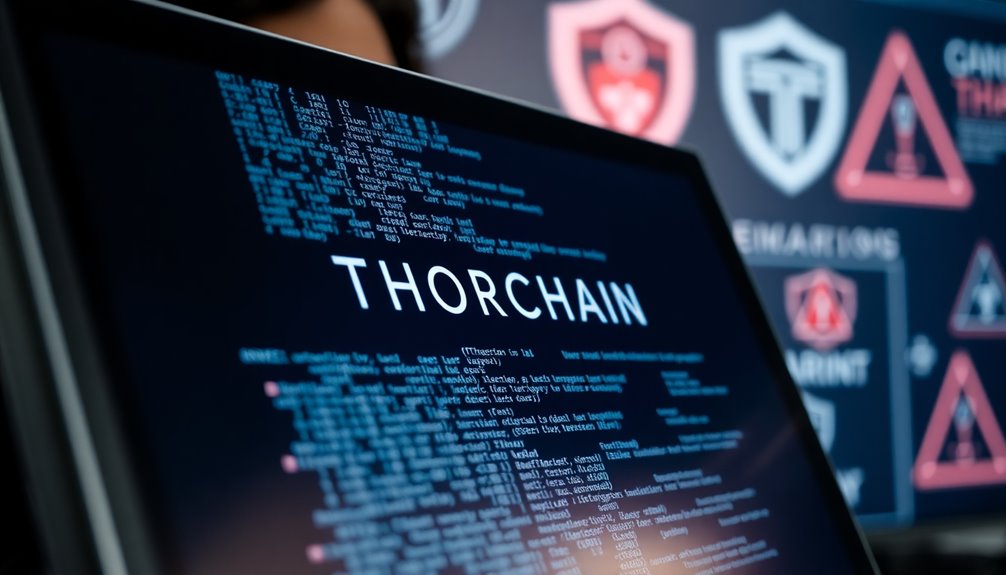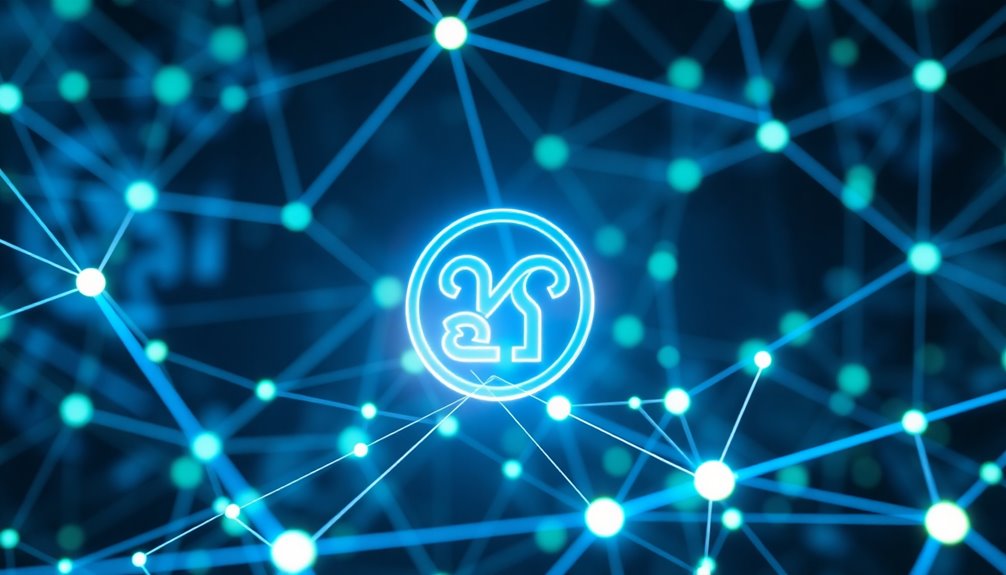THORChain (RUNE) is a decentralized liquidity protocol that lets you swap assets across various blockchains seamlessly. You can trade directly, utilizing its automated market maker (AMM) model without relying on wrapped tokens. As a liquidity provider, you can earn rewards by contributing to liquidity pools. RUNE serves multiple purposes, including transaction fees and governance, enhancing network value. While the protocol offers native asset swaps and security benefits, it also faces challenges such as past hacks and complexities in cross-chain transactions. To better understand its features and advantages, uncover more about THORChain's unique offerings and functionalities.
Key Takeaways
- THORChain facilitates seamless cross-chain asset swaps using its AMM model, promoting decentralized trading without wrapped tokens.
- RUNE is the native token, essential for transaction fees, governance, and boosting liquidity in the ecosystem.
- Liquidity providers can earn rewards by contributing to continuous liquidity pools, enhancing trading efficiency and reducing slippage.
- Security is bolstered through node operators staking RUNE, community governance, and regular audits to identify vulnerabilities.
- Users can engage directly with the THORChain Wallet, fostering community-driven governance and transparency in protocol changes.
Core Concepts of THORChain

When you explore THORChain, you'll find it operates as a decentralized liquidity protocol that empowers users to swap native assets across various blockchains seamlessly.
At its core, THORChain utilizes liquidity pools and an automated market maker (AMM) model, allowing you to trade directly from your wallet while maintaining control over your funds.
The native token, RUNE, plays a crucial role in this ecosystem, facilitating cross-chain swaps, covering transaction fees, and providing liquidity rewards.
Its unique dual-swap mechanism lets you exchange non-native tokens securely using RUNE.
Additionally, the network's security relies on node operators who stake RUNE, ensuring their bonded assets exceed the value of secured assets, thus enhancing trustlessness and decentralization within the liquidity protocol.
Overview of THORChain's Ecosystem

As you dive into THORChain's ecosystem, you'll discover a robust framework designed for seamless cross-chain asset swaps. This decentralized liquidity protocol enhances cross-chain liquidity by enabling interactions among major blockchains like Bitcoin, Ethereum, and BNB Chain without relying on wrapped tokens.
The use of automated market maker (AMM) functionality allows liquidity providers to contribute to pools and earn rewards, fostering a vibrant decentralized finance (DeFi) environment. At the heart of this ecosystem is RUNE, the native token that serves essential roles, including transaction fees and governance participation.
With the THORChain Wallet, users can engage directly with the network and benefit from the community-driven governance model, ensuring transparency and active involvement in protocol changes.
Liquidity Through Cross-Chain Swaps

THORChain revolutionizes the way you trade assets by allowing native swaps across different blockchains without needing wrapped or synthetic tokens. This unique approach significantly enhances liquidity for cross-chain trading, making it easier for you to exchange assets like Bitcoin, Ethereum, and BNB using RUNE tokens as the intermediary.
By utilizing an automated market maker (AMM) model, THORChain enables liquidity providers to contribute to pools and earn rewards, fostering a vibrant DeFi ecosystem. The continuous liquidity pools (CLPs) ensure that prices adjust dynamically based on trade sizes, which helps minimize slippage and impermanent loss.
With THORChain, you gain access to a robust platform that promotes efficient trading and a diverse range of options in the decentralized finance space.
Pros and Cons of THORChain

While exploring decentralized finance, you'll quickly notice the distinct advantages and disadvantages of THORChain.
On the pro side, it enables native asset swaps across blockchains, enhancing liquidity while reducing reliance on centralized exchanges. Plus, THORChain operates on a non-custodial basis, ensuring you maintain control of your funds, aligning perfectly with DeFi principles.
RUNE, its native token, is vital for governance, staking, and liquidity rewards, tying its value to network growth and security.
However, the protocol has faced security challenges, including past hacks, raising concerns about network security. Additionally, the complexity of cross-chain transactions might pose a learning curve for some users, potentially limiting accessibility for those new to decentralized finance.
THORCHAIN vs. Uniswap Mechanics

When comparing the mechanics of THORChain and Uniswap, you'll notice significant differences that cater to various user needs.
THORChain operates as a cross-chain decentralized protocol, allowing native asset swaps directly across different blockchains without relying on wrapped tokens. This enhances user experience by reducing complexity.
In contrast, Uniswap focuses solely on ERC-20 tokens within the Ethereum ecosystem, which requires synthetic assets for cross-chain functionality.
Both protocols use an automated market maker (AMM) model, but THORChain's dual-swap mechanism utilizes its RUNE token as an intermediary for non-native exchanges.
Additionally, THORChain's non-custodial nature ensures you maintain full control over your assets during swaps, while Uniswap's liquidity pools entail swap fees that can affect your returns.
Security Vulnerabilities in Protocols

Security in decentralized protocols is crucial, especially given the evolving landscape of blockchain technology.
THORChain has faced security vulnerabilities, highlighted by a significant hack in July 2021 that resulted in an $8 million loss. To combat these risks, the protocol employs decentralized governance, allowing community input to guide enhancements.
Node operators must bond RUNE tokens, ensuring economic security by maintaining a bond value that exceeds the secure asset value. Regular audits and updates of the open-source code help identify and address vulnerabilities promptly.
However, utilizing an automated market maker (AMM) model also introduces risks like impermanent loss and price manipulation, so ongoing monitoring and risk management strategies are essential to safeguard the network and its participants.
Emerging Cross-Chain Innovations

As the demand for cross-chain functionality grows, THORChain is at the forefront of innovation, offering a unique dual-swap mechanism that streamlines the exchange of non-native tokens.
By utilizing RUNE as an intermediary, you can enhance your cross-chain trading efficiency without the hassle of wrapped tokens. The protocol's integration with the Cosmos SDK and Inter-Blockchain Communication (IBC) allows for seamless asset swaps across multiple blockchain networks.
This non-custodial approach ensures you maintain control of your funds, fostering trust and security in decentralized finance (DeFi) transactions.
With upcoming features like EdDSA support and Active Yield mechanisms, THORChain aims to further elevate secure cross-chain communication and user experience, making it an exciting time to engage with this evolving ecosystem.
Utilize Liquidity Pools Effectively

To effectively utilize liquidity pools in THORChain, you'll want to understand how they work and the benefits they offer.
Liquidity pools enable you to contribute assets like Bitcoin, Ethereum, or BNB and earn a share of the swap fees generated, enhancing your returns in decentralized finance.
By pairing your assets with RUNE, you facilitate seamless cross-chain swaps without needing wrapped tokens. The automated market maker adjusts prices based on supply and demand, optimizing your trade execution and reducing slippage.
While you'll face potential impermanent loss due to market fluctuations, participating in liquidity pools can still be rewarding.
Consider single asset options through Savers Vaults if you're looking to minimize RUNE exposure while contributing to market liquidity.
Frequently Asked Questions
Can RUNE Reach $100 Dollars?
You might wonder if RUNE can reach $100. While it's possible, achieving that price would depend on several factors, including market demand and adoption.
If more people start using the platform and the total value locked increases, you could see a surge in RUNE's price.
Additionally, upcoming features and overall market sentiment play crucial roles.
Keep an eye on the DeFi sector, as it may influence RUNE's potential growth significantly.
What Is the Difference Between RUNE and THORCHAIN?
Imagine you're trading Bitcoin for Ethereum effortlessly. RUNE and THORChain work together to make that happen.
RUNE is the native token that fuels the protocol, while THORChain is the decentralized platform facilitating the swaps. You can think of RUNE as the currency you use, while THORChain is the engine driving the entire operation.
Without RUNE, you wouldn't have a means to support liquidity and governance within the THORChain ecosystem.
Is THORCHAIN RUNE a Good Investment?
When considering if THORChain RUNE is a good investment, you should weigh its growth in total value locked and its limited supply, which could drive demand.
RUNE's utility in governance and staking also enhances its appeal. Plus, the protocol's focus on security and a strong community suggests ongoing innovation.
If you believe in the future of cross-chain liquidity and decentralized finance, it might be worth exploring further for your portfolio.
Is THORCHAIN RUNE an ERC20 Token?
No, THORChain's RUNE isn't an ERC20 token. Instead, it stands strong as a native currency on its own blockchain, built for seamless swaps across various platforms.
While many tokens tether themselves to Ethereum's standards, RUNE thrives independently, allowing you to engage in cross-chain transactions without wrapped tokens.
With a capped supply of 500 million, it offers unique features like staking and governance, making it a distinctive player in the crypto cosmos.
Conclusion
In the vibrant world of decentralized finance, THORChain stands out with its unique cross-chain capabilities, offering both opportunities and challenges. While it empowers users with seamless swaps, the complexities of liquidity pools can feel daunting. Yet, when you grasp its mechanics, you unlock a realm of potential that rivals traditional platforms like Uniswap. So, embrace the innovation of THORChain, weigh its pros and cons, and navigate the landscape with confidence—your journey into cross-chain liquidity awaits!









